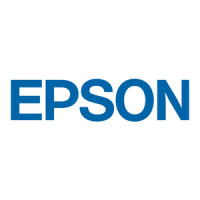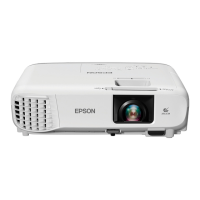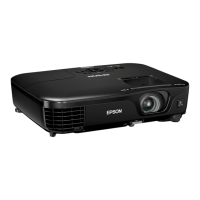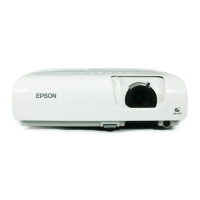Epson PowerLite S4
6/06 Epson PowerLite S4 - 5
Adjusting the Image Shape
To avoid projecting with a distorted image shape, make sure the
projector is positioned in line with the center of the screen (not
to its left or right). Make sure the projector faces the screen
squarely.
If the image is distorted after raising the projector, you can use
the projector’s keystone correction function to adjust the shape.
Note: You can correct only vertical keystoning with this function.
Images can be corrected when the projector is tilted to a maximum
of ±30° for images with a 4:3 aspect ratio, or ±20° for 16:9
images.
Press the
u or d buttons to correct keystone distortion:
Note: The screen size changes when keystone correction is
performed. If you notice reduced image quality after adjusting the
shape, decrease the sharpness setting.
Adjusting Computer Images
If you’re projecting from a computer, the projector’s Auto
Setup
function automatically adjusts the image for the best
quality. However, if
Auto Setup in the Signal menu is turned
off, you need to press the
Enter button on the projector to
make the adjustment. This corrects the tracking, sync, and
position settings. Turn off
E-Zoom and A/V Mute before
pressing this button.
Sometimes the image may not adjust correctly, depending on
the type of signal output by the computer. Use the projector’s
Tracking, Sync, and Position settings in the Signal menu if
your notice any of these problems:
❏ Flashing or blurry image
❏ Vertical or horizontal stripes
❏ Only a portion of the image is displayed
See the User’s Guide for more information.
Selecting the Color Mode
There are seven color modes.
The mode changes each time you
press the
Color Mode button on
the remote control. Make a
selection appropriate for the
image and current conditions.
❏ Photo (Computer or RGB video)
Images are vivid and high-contrast. Ideal for projecting still
pictures, such as photos, in a bright room. Photos that are
under- or over-exposed look best in this mode.
❏ Presentation
Ideal for giving presentations in a bright room
❏ Theatre
Gives images a natural tone. Ideal for watching films in a
dark room.
❏ Game
Excels at emphasizing dark gradations. Ideal for playing
video games in a bright room.
❏ sRGB
Conforms to the sRGB color standard. If the connected
source has an sRGB mode, set both the projector and the
connected source to sRGB.
❏ Blackboard
When projecting onto a blackboard (green board), gives
your images a natural tint, just like projecting onto a screen.
Note: You can also change the color mode through the Image menu.
Selecting the Aspect Ratio
The aspect ratio is the ratio between an image’s width and its
height. Standard images have an aspect ratio of 4:3 and HDTV
and DVD images have an aspect ratio of 16:9. If your video
source is 16:9, you can change the aspect ratio to view the video
in 16:9 wide-screen format.
Color
mode
button

